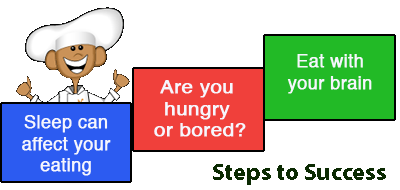Developing Emotional Intelligence: Preventing Food Addiction

Emotions can be experienced predominately as a feeling involving the stomach: think the butterflies of anticipation or the ache of sorrow. Without developing emotional intelligence, children can interpret these stomach sensations as hunger and learn to eat in response to their emotions. “Emotional eating,” or depending on food to feel better when emotional, has been identified by persons suffering from various types of eating disorders. Parents can take the following steps with children to increase emotional intelligence (the awareness and expression of one’s and other people’s emotions) and decrease the possibility that children develop emotional eating.
-
Teach children to pay attention to their feelings; emotions are important signals
-
Signals are neutral, not good or bad, the same is true of emotions, although some might feel very powerful
-
Some common emotional signals are:

-
Fear signals threat and prepares people to confront or get away
-
Happiness signals the presence of good things to share
-
Anger signals a blocked goal and energizes efforts to reach the goal
-
Excitement is a signal to follow the trail of something that might benefit
-
Sadness signals others that a loss has occurred and promotes caretaking
-
Emotions signal people that there is something in the environment that requires attention to and in response to these signals children should act appropriately Learning to act appropriately takes time. Young children can be frightened by powerful emotions and carried away by their feelings into inappropriate acting out such as hitting in response to anger. Acting out is typical of young children and they should not be made to feel badly about such behavior, but taught to use words, not impulsive actions, to solve problems.
-
Parents can use books and stories to teach about emotions. The book, How Are You Peeling? Foods with Moods (2004) can help children identify emotions.
-
Other books can help young children respond appropriately to their feelings: My Many Colored Days by Dr. Seuss; Today I Feel Silly: And Other Moods that Make My Day by Jamie Lee Curtis, and When Sophie Gets Angry by Molly Bang.
-
Books can also aid parents in teaching young adolescents emotional intelligence: The Feelings Book: The Care & Keeping of Your Emotions by Madison & Bendell (2002) can help girls understand their emotions and what to do in response to them.
-
A frank look at becoming a teen, including emotional development, is provided in American Medical Association Boy's Guide to Becoming a Teen
Children can learn that emotions are like waves – they start small, then rise, crest, peak, and recede.
Healthy Eating

Healthy Child

Written by Lisa Hinz PhD
•
Written on Aug 15, 2013
•
Last updated on Aug 16, 2013



0 Comments